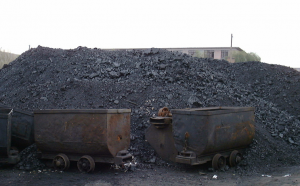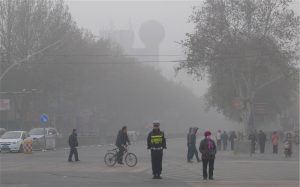Beijing on Tuesday declared its first ever red smog alert, forcing millions of cars off the roads and the closure of factories and construction sites as China’s capital once again tries to deal with another bout of severe air pollution.
The red alert, which also advises offices and schools being allowed to close, enables drastic measures that are usually reserved for major events such the Second World War victory parade held in early October this year.
Although the current levels of smog aren’t as high as at other times this year, the persistent levels of toxic air over a period of several days have prompted the red alert, as visibility has fallen to just a few hundred metres and the threat to public health increases.
Levels of PM2.5, tiny fragments of particulate matter deemed highly harmful as they are inhaled deep into the lungs, were measured to be as high as 350 microgrammes per cubic metre early Tuesday evening Beijing time, compared with 25 microgrammes the level the World Health Organisation thinks it is safe to inhale.
Early last month, levels of PM2.5 exceeded 1,000 microgrammes per cubic metre in some parts of the city, but then soon dispersed. This time round the smog is hanging around for longer.
The red alert, which began at 7am local time today, will run until midday on 10 December, the first time a red alert has been issued by Beijing’s municipal pollution command centre. An orange alert had already been in place since the weekend, prompting questions from Beijing’s residents about why a red alert wasn’t declared sooner.
Experts explained in Chinese language media that the authorities had been reluctant to declare a red alert until it was sure that smog-forming weather conditions–such as humidity and lack of wind–would persist for several days.
The drastic measures required by a red alert, such as banning half the city’s cars from the roads and forcing factories to close, have a huge economic cost in a city of over 20 million people.
Beijing has seen suffered several bouts of smog since the arrival of colder weather in autumn. The first smog alert in the latter half of the year came into effect on October 5, just days after ‘Parade Blue’ skies were seen over Beijing and altogether, eight have been issued so far since the summer– two blue alerts, three yellow, two orange and one red.
In March, Beijing updated its plans for responding to severe pollution. The city has four levels of alert: If ‘severe’ pollution is expected to continue for one day, a blue alert is issued; for two days a yellow alert; for three days an orange alert, and for any longer than three days a red alert.
Although much of Beijing’s pollution migrates from surrounding provinces, where heavy industry and district heating emits harmful particulates and burns large amounts of smog-causing coal, around two-thirds of the capital’s toxic air is judged to come from sources within the city limits. Vehicles are estimated to account for one-third of Beijing’s smog, with construction, household burning of coal and other highly localised activities believed to account for the remainder.




